Abstract
The importance of new models of support for innovative decision-making in agriculture is explained by the requirements of legislation on strategic planning. It is justified that the introduction of projects for the development of high technologies in agriculture is not advisable without tools to assess their effectiveness and risks in order to reduce uncertainty in the biotechnology development of the industry. It has been shown that there are not enough methods for discounting investment investments. With the use of econometric analysis tools, the dependence of financial results on investments in scientific research was assessed according to the financial statements of advanced biotechnology companies at the international level. Models have been formed to estimate payback and optimize R & D cost parameters. The obtained data confirm the hypothesis on the importance of scientific factor in the progressive development of agricultural economy, allow one to describe investment processes in innovation activities of producers, contribute to increase of reliability of results of forecasting of biotechnology development of agriculture.
Keywords: Biotechnologies, R&D costs, efficiency of innovations, forecasting models, strategic planning
Introduction
Today, when many world powers follow containment policy of agrarian production, Russia, on the contrary, intends to make break in this direction, having shown the defined progress of agricultural industry in recent years. The strategic task of import substitution in the market of food is set for the agrarian sector. "Russia has no right to be vulnerable …, it is necessary to set the task of the national level and by 2020 to completely provide domestic market with domestic food …, … to become the largest world supplier of healthy, eco-friendly, quality products of food", the president's letter to Federal Assembly for 2016 reads (President's letter, 2015, par. 5, p. 4). Already at that time, in connection with imposition of an embargo of import goods and change of an environment of the food market, there was a precedent on the accelerated import substitution. The share of import food products in commodity resources of home shopping service for the end of 2015 decreased to 28%, for the end of 2017 – to 25%, in the middle of 2018 – to 22% (EMISS State statistics, 2018).
For fixing the dynamics of the forward development, there was a need to increase the system effectiveness of management of economic growth. In this connection the Strategy of scientific and technological development of the Russian Federation (Presidential decree, 2016a), which marked transition to scientific bases of formation of a system of strategic planning of development of the industries and spheres of economy, including the agrarian sector, was accepted.
Problem Statement
In the conditions of the achieved production success in agricultural industry by separate positions, threats remain in the sphere of innovative development of agrarian and industrial complex. In particular, the sharpness of a problem is shown at the low level of development of the breeding and selection base. By estimates of the Ministry of Agriculture of the Russian Federation, the used landing, sowing and breeding material of main types of products, more than a half is delivered from the countries participating in economic sanctions against Russia. It is obvious that even the reached level of food sovereignty of the country is under the threat is due to decrease in solvent demand for separate food (Miloserdov, 2015).
According to provisions of the Doctrine of food security the technological hazards caused by lag in the level of technological development of domestic production base from production base of developed countries, differences in requirements to safety of foodstuff and the organization of a control system for their observance belong to number of the most significant risks in the sphere of food security. Now the most demanded domestic technologies based on the latest developments of science do not find application in agrarian production. At the same time, according to the forecast of scientific and technological development of agro-industrial complex of the Russian Federation until 2030, in Russia by the beginning of 2016 there had been about 436 organizations (10.4% of all organizations) who were carrying out research and development in the field of agricultural sciences (National report, 2017).
Against the background of the almost 2.2-time growth of costs of science in Russia since 1994, the share of agricultural sciences in their total amount was steadily reducing, having reached a minimum in 2014 - 2015 - 1.6% (in 1994 - 3.6%).
According to the Presidential decree of the Russian Federation (Presidential decree, 2016b), the Federal scientific and technical development program of agricultural industry for 2017 – 2025, which purpose is scientific technological support of development of agricultural industry and decrease in technological hazards in the food sphere, was developed (Government decree of the Russian Federation № 996, 2017).
Implementation of this program will allow one not only to remove technological dependence and dependence in crop production, livestock production, veterinary science, forage production, storage and processing of agricultural products, but also to provide existence in the Russian market of high-quality and competitive agricultural domestic products, to make the system of agrarian education the driver of development of agro-industrial complex (Government official site of the Russian Federation, 2016).
Accumulation of scientific and technological capacity of the Russian agro-industrial complex will allow reducing step by step its dependence on import of technologies, seeds, diagnostic aids and protection of plants, medicines for veterinary application and other resources. The increase in innovative activity planned by governing bodies of agrarian and industrial complex in agricultural industry by 2025 is 30%.
Innovative development of the agrarian sector is impossible without cardinal investment break which ensuring is supported in recent years only due to increase in budgetary appropriations (to more than 234 billion rubles in 2017) and attraction on their basis of credit resources of banks (more than 1 trillion 200 billion rubles in 2017). For development of scientific research in agricultural industry, the essential growth in volumes of financing of costs of innovations from 1 billion 732 million 151 thousand rubles in 2017 to 6 billion 241 million 961 thousand rubles in 2025 (figure 1) is offered.
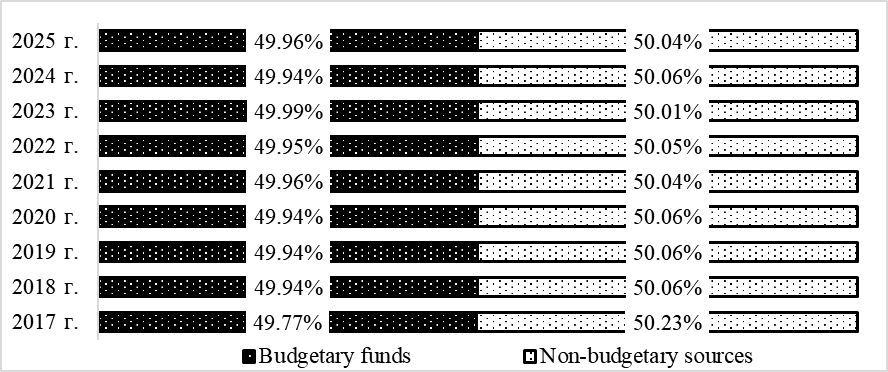
According to forecasts of the Ministry of Agriculture of the Russian Federation, a significant increase in the amounts of financing of scientific research in agricultural industry, almost by a half, it is supposed to provide at the expense of the budgetary sources (Samygin & Kudryavtsev, 2018).
So far cumulative expenses on research and development in Russia make only 39.9 bln. dollars that in relation to the USA and China makes only 8% and 11%, respectively. From this sum, nearly 68% is carried out at the expense of the government budget. At the same time, the state participation in the USA and China makes about 28% and 21%, respectively (National Science Board, 2016).
Research Questions
It is at the moment difficult to expect significant injections in an innovation in the village from the private capital. At this conjuncture, an unusual situation in the domestic market of food, the investment climate in the agrarian sphere worsened, because of the external economic calls and restrictions, the appeal of agrarian business to owners of spare capital decreased. Even the largest agricultural holdings announced the suspension of their new projects (Aganbegyan, 2016).
Many scientists continue to look for solution of the problems of innovative development of agricultural industry in a growth in volumes of budgetary appropriations on the industry (Petrikov, 2018; Zaruk, 2016), comparing them to volumes in developed countries (Kung, Wu, 2020). Without looking at clear advantages of these offers, authorities are not ready to include such organizational and economic measures yet. Therefore, it is necessary to involve the entire available agrarian potential to reveal reserves and to mobilize all resources of agrarian growth for what other approaches to formation and realization of agrarian policy are necessary essentially (Samygin et al., 2019).
Purpose of the Study
The purpose of the work is to build models for forecasting the effectiveness of R&D costs in the agricultural business and carry out experimental calculations on them.
Research Methods
The monitoring of implementation of the priority national project and state programs in agricultural industry, which scientists of VNIOPTUSH carry out in a number of territorial subjects of the Russian Federation, showed that many heads of agricultural organizations support the projects on receiving biogas and bioenergy. Biotechnologies that promote an increase and improvement of quality of food and medicinal products, development of agricultural industry and industries of economy, hi-tech methods of prevention of diseases, diagnostics and treatments are the most attractive today. Development of biotechnological production and increase in costs of research in this sphere will allow one to increase employment of the population and to reduce outflow of qualified personnel. It is also impossible to exclude increased security due to creation of new medications. But this sphere is little explored and there are almost no tools for reduction of uncertainty and risk assessment (Bespakhotny, 2017).
The solution of problems of such character is possible on the basis of implementation of measures of support for implementation of high technologies to develop innovations in the village, to subsidize costs of research and development (Aissaoui, 2014). Of course, development of the biotechnological companies in the village has certain difficulties, in particular, big risk of loss of monetary investments and a long payback period. But investments into these industries are worth it. It is known that the large foreign companies invested billions of dollars in research on biotechnology and genetic engineering and now are monopolists in the market of seeds. In the new state program in agricultural industry, this direction practically is only designated as financing is not provided (Putsenteilo et al, 2020). In the Strategy of innovative development of Russia until 2020 accepted by the Government of the Russian Federation, it is planned to provide wide use in agrarian and industrial complex of biotechnologies which have to change the traditional agrarian sector (Glazyev, 2008).
Therefore, the major scientific problem following from the need for new strategic decisions within the preparation of the effective answer to the big food and connected with it calls is connected with development of tools of strategic planning of innovative development of the agrofood sector. Imitating opportunities of instruments of strategic regulation of the agrarian sector, in principle, allow one to expect risks of forward development, to avoid unjustified public costs and dangerous social consequences. In modern Russian conditions of development of agricultural industry, it is difficult to do without obvious description of investment processes and their influence on operational and financial and economic performance of the industry.
The modern order of assessment of innovative projects in agricultural industry is based on the system of standard methods of assessment of efficiency of investments which algorithms of calculation of indicators are stated in normative legal acts of the Ministry of Finance and the Ministry of Economics of Russia. The methodological problem of these methods is that such order is based only on discounting of future income and does not provide information to owners of the capital about quantitative influence and functional communications of expenses on scientific research on financial results of economic activity. The nature of costs of research and development such is that the research on their influence on activity of producers is quite limited. The basic difficulty of determination of efficiency of investments in research and development consists in complexity of exarticulation to directly affect them in a set of the factors influencing the financial result. The interrelation of costs of research and development and the majority of indicators has stochastic character; therefore, it is possible to study their influence on financial results on the basis of the econometric analysis when the narrowness of interrelation and quantitative dependence of costs of research and development decide on productive indicators among. It is expedient to use revenue, net profit and profitability with the analysis of a share of the revenue reinvested by the enterprises in scientific research.
Findings
According to financial statements of 90 leading international companies in the sphere of biotechnological production, which receive the approximate volume of annual revenue from 120 to 14,500 mln dollars, net profit – from 19 to 4,196 mln dollars and carry out investments in research and development approximately at the level of 40.5 – 3,030 mln dollars. The econometric research was conducted; therefore, functional communication of financial results and costs of research and development (figure 2 and figure 3) is revealed.
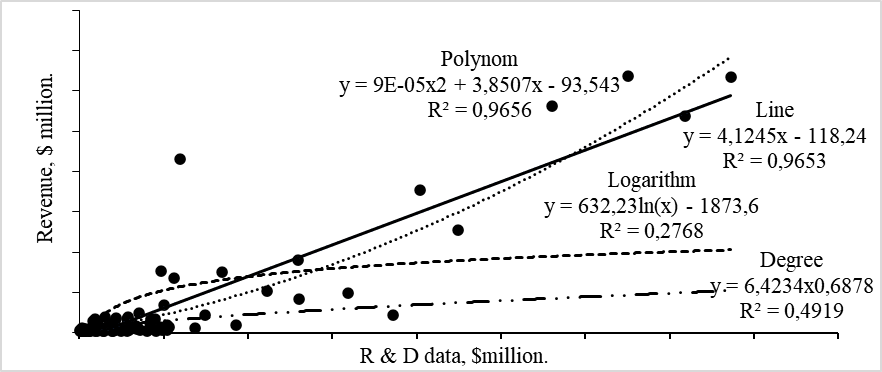
Communication of such expenses in the biotechnological companies with revenue and profit is rather big. It is estimated at the level of respectively 98.2% and 88.4% (correlation coefficient), and the company makes dependence of revenue and profit on these expenses in such according to 96.5% and 78.2% (determination coefficient).
By results of the conducted research, the linear and polynomial dependence of revenue and profit on costs of research and development with determination coefficients at the level of 96.5% is observed. It proves huge value of annual expenses on scientific and research activity for successful business in this industry (table 1).
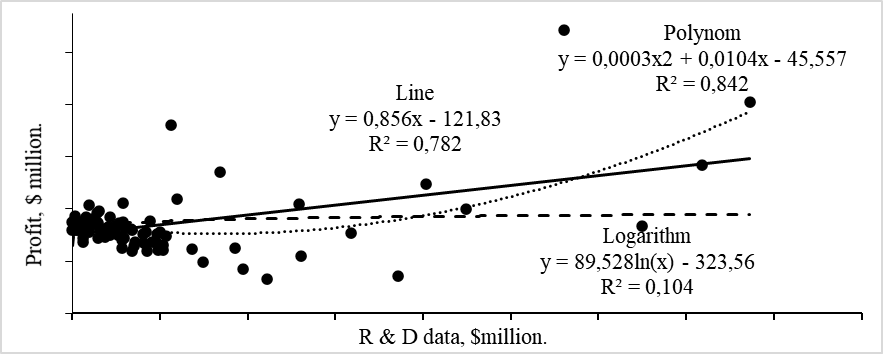
Assessment of elasticity of models shows their economic sense that with the increase in cost of research and development by 1 million dollars; the total sales of the biotechnological companies will increase more than by 4 million, and profit - more than by 850 thousand rubles; at the level of profitability of sales – about 21%. The additional research shows that the importance of the received functionalities satisfies Fischer's criterion, and their parameters will be coordinated with Student’s criteria.
The in-depth study of costs of research and development in the biotechnological organizations shows that their share in revenue (coefficient of costs of research and development) occupies on average 54% with the variation level on companies of 10%-80%. Econometric studying the called coefficient indicates its communication with key performance indicators of economic activity (coefficient of correlation of 84%).
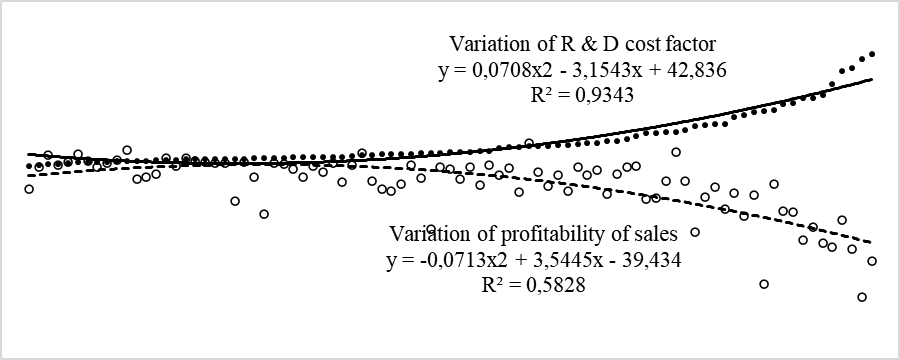
During the growth of a share of costs of research and development in revenue, there is an increase in profitability of sales of the biotechnological companies. However, at a certain stage the growth rate of a share of such expenses begins to exceed growth rate of profitability.
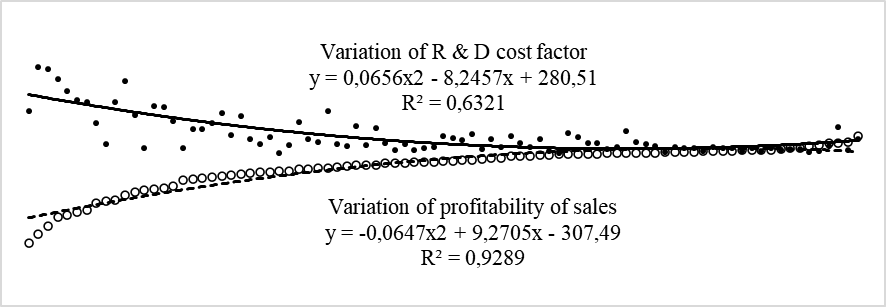
Having calculated the functionalities describing behaviour of profitability during the growth of the coefficient of costs of research and development (figure 4) and behaviour of the coefficient of costs of research and development during the growth of profitability (figure 5) the optimum share of expenses on scientific research in the revenue of the company possibly makes 27%-65%. At the same time, profitability of sales will make 7%-22% in the conditions of inflation at the level of developed countries of 0.5%-1.5%.
Conclusion
Development of biotechnological production and the increase in the costs of research in this sphere will allow one to increase employment of a rural population and to reduce outflow of qualified personnel to the cities. Besides, development of the agro-industrial sector of economy, due to increase in biotechnologies, can increase agricultural export, provide the country with food, reduce import and prime cost of agricultural products and increase the level of environmental safety of food. Partial reorientation of the state support to development of innovations in agricultural industry will promote financial security of the future of this industry. The models of dependence of revenue and profits on costs of research and development and models of optimization of a share of such expenses in revenue will promote improvement of the mechanism of strategic planning and forecasting of development of economy of the agrarian sector. This will allow one to strengthen tool support of anticipation of innovative development of agricultural production, create conditions for effective strategy implementation of scientific and technological development of Russia.
References
Aganbegyan, A. G. (2016). How to overcome stagnation and to restore economic development. ECO, 2, 2-14
Aissaoui, S. (2014). A double–hurdle model for innovative performance: the role of university-industry collaborations. International Journal of Innovation and Applied Studies, 9, 1087–1096.
Bespakhotny, G. V. (2017). To planning in agrarian and industrial complex scientific providing. Economy agricultural and processing enterprises, 10, 8-12.
EMISS State statistics. (2018). The share of imported food products in the commodity resources of the retail trade in food products. https://www.fedstat.ru/indicator/37164
Glazyev, S. Y. (2008). About the strategy of social and economic development of Russia till 2020. Economic strategy, 3, 20-29
Government decree of the Russian Federation N 996. (2017). About the approval of the Federal scientific and technical development program of agricultural industry for 2017 – 2025. http://government.ru/docs/29004/
Government official site of the Russian Federation. (2016, April 19). Report of the Government on the results of work in 2015. http://government.ru/news/22717
Kung, C.-C., & Wu, T. (2020). A spatial equilibrium analysis of using agricultural resources to produce biofuel. Agric. Econ. – Czech, 66, 74–83.
Miloserdov, V. V. (2015). Food security and measures for its providing, Yekaterinburg: Ural publishing house.
National report. (2017). National Innovation Paper in Russia - 2017. http://www.rvc.ru/upload/iblock/c64/RVK_innovation_2017.pdf
National Science Board. (2016). Arlington, VA: National Science Foundation Science and Engineering Indicators, 4, 45-46.
Petrikov, A. V. (2018). Use of innovative technologies various categories of farms and improvement of scientific and technological policy in agricultural industry. Agrarian and industrial complex: economy, management, 9, 4-11
Presidential decree. (2016a). of Russia N 350 "About measures for realization of the public scientific and technical policy for the benefit of development of agricultural industry"
Presidential decree. (2016b). of the Russian Federation N 642 "About the Strategy of scientific and technological development of the Russian Federation"
President's letter. (2015). of the Russian Federation to Federal Assembly. http://www.kremlin.ru/events/president/transcripts/messages/50864
Putsenteilo, P., Klapkiv, Y., Karpenko, V., & Gvozdecka, I. (2020). The role of institutions in the development of agriculture. Bulgarian Journal of Agricultural Science, 26(1), 23–33.
Samygin, D. Y., Baryshnikov, N. G., & Mizjurkina, L. A. (2019). Models of Scenario Forecasting of the Region’s Agriculture. Economy of region, 15(3), 865-879.
Samygin, D. Y., & Kudryavtsev, A. A. (2018). Strategic instruments of state support distribution in the agrarian sector. Ekonomicheskaya Politika, 13(5), 156–175.
Zaruk, N. F. (2016). Stages of development of investment process in agricultural industry of Russia. Agrarian scientific magazine, 1, 32-37.
Copyright information

This work is licensed under a Creative Commons Attribution-NonCommercial-NoDerivatives 4.0 International License.
About this article
Publication Date
01 July 2021
Article Doi
eBook ISBN
978-1-80296-112-6
Publisher
European Publisher
Volume
113
Print ISBN (optional)
-
Edition Number
1st Edition
Pages
1-944
Subjects
Land economy, land planning, rural development, resource management, real estates, agricultural policies
Cite this article as:
Samygin, D. Y., Kelejnikova, S. V., Kopylova, E. V., & Soldatkina, S. M. (2021). Foresight Of Models Of Efficiency Of Scientific Expenses In Agrarian Business. In D. S. Nardin, O. V. Stepanova, & V. V. Kuznetsova (Eds.), Land Economy and Rural Studies Essentials, vol 113. European Proceedings of Social and Behavioural Sciences (pp. 1-9). European Publisher. https://doi.org/10.15405/epsbs.2021.07.1

